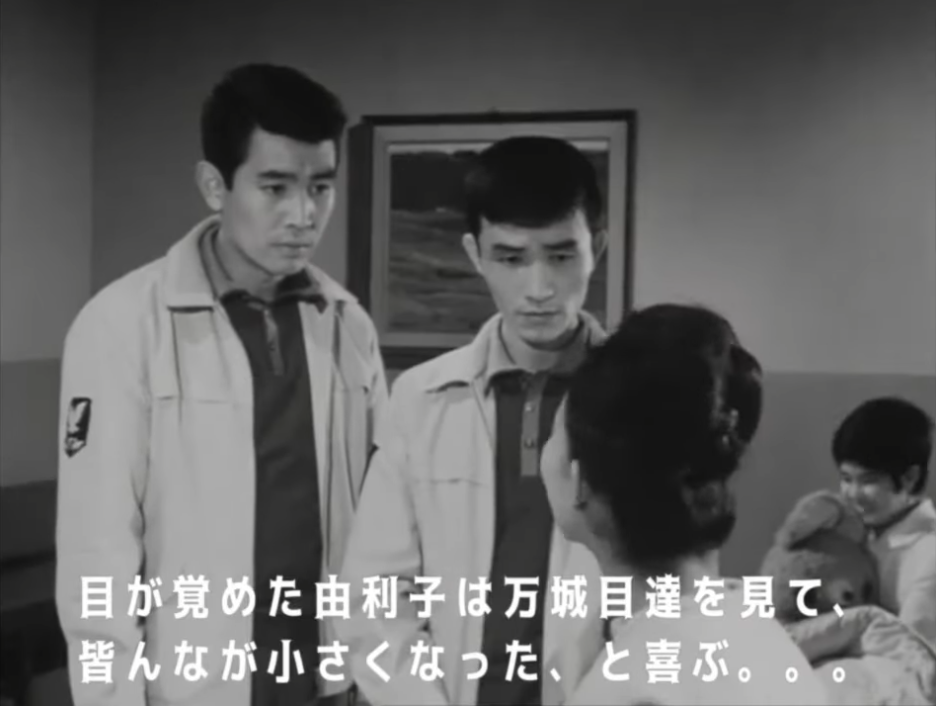
Good morning everyone,
Today’s review is going to examine a 1960s black and white Japanese TV series called “Ultra Q.” Tsuburaya Productions created Ultra Q and Tokyo Broadcasting System (TBS) first aired the show in 1966. Of interest, Eiji Tsuburaya, “the father of Tokusatsu,” founded Tsuburaya Productions in 1963. He previously worked on a little known monster film called Godzilla, maybe you’ve heard of it? 😉 (NOTE: Click here for Eiji’s biography at the official Tsuburaya web page.)
Toho, the company which created Godzilla, also invested in Tsuburaya’s company and gave him old props, such as an old Godzilla suit which was modified to make Ultra Q’s very first monster, Gomess.
Ultra Q’s single season followed two aviators, Ippei Togawa and Jun Manjome, who worked together at Hoshikawa Air Service, and Yuriko Edogawa, a reporter who worked at the Daily News. The trio encountered a variety of different aliens, monsters, and supernatural entities on a regular basis.
This review is the first in a series which will focus on the Ultraman franchise and in particular the influence that the franchise exerted on size-themed productions. Tsuburaya Productions and TBS aired Ultraman a mere week after Ultra Q ended. Ultraman proved to be quite popular and created many spinoffs.

While Ultraman himself did not appear in Ultra Q many of his monstrous foes first appeared in Ultra Q. For instance, the giant 40-meter tall remote-controlled monster ガラモン “Garamon” appeared in episode 16 of Ultra Q and later reappeared in episode 8 of Ultraman as the much smaller 1-meter tall ピグモン “Pigmon.” (NOTE: According to the Ultraman Wiki, Pigmon was an abbreviation for “Pygmy monster.”)

Additionally, the Kemur aliens first appeared in Ultra Q and then went on to battle various versions of Ultraman. Furthermore, the “Cicada Man” who controlled Garamon re-appeared as a member of the Baltans, an alien race battling Ultraman.
Ultraman influenced several size-themed Japanese stories. For example, the giantess Papico, protagonist of Hiroya Oku’s manga GIGANT, said she wanted to be Ultraman when she was young.

Additionally, Nitroplus mascot Super Sonico cosplayed as the Kyodai (meaning giant) hero in a short video clip entitled ウルトラソニコ “UltraSonico.” Nitroplus publicly released UltraSonico on April 1st, 2017 via YouTube. Their original posting has been removed, but another YouTuber re-uploaded it with Korean subtitles.

Ultraman inspired numerous live-action Japanese giantess films including, but certainly not limited to, “Evil Gigantic Female Alien Glamouria,” “Gigantic Heroine HyperMommy Σ,” and “Mighty Lady: New Episode.” Foreign creators, such as Ron Wilber, also created works inspired by Ultraman. Wilber made “Ultima-Woman,” a three-issue adult-oriented series for Eros Comix, in 1995.

These Ultra reviews will provide background on the Ultraman franchise and how it came to influence size-themed erotica. With all that noted, let’s dive into this franchise where it first started with Ultra Q. Two episodes featured people of unusual size.

The first episode of note was “The 1/8 Project.” This was the 17th episode and first aired on April 24, 1966. It began with Yuriko being nearly crushed on the stairs of a crowded train station. Afterward, she investigated a public event promoting Japan’s new 1/8 Project. This was an initiative to combat overpopulation by shrinking people down to 1/8th regular size. The shrunken people reside in Model District S, an entire neighborhood including appropriately-sized buildings, cars, houses, streets, traffic cops, etc. Yuriko was unknowingly swept up in a crowd heading toward the elevator to be shrunk.

She quickly learned that she had been shrunken and authorities detained her for trespassing, entering without a passport. She protested by emphasizing that she accidentally went on the elevator. Alas, the authorities merely replied “The law is the law” and carried her to a holding cell for processing. (SIDE NOTE: Maybe scientists should check for proper paperwork before reducing someone in size? Just a thought!)
A series of misadventures followed in which Yuriko floated in a box down the river, encountered a pair of helpful nuns, and tried to contact her friends Ippei and Jun. Eventually, they received her goodbye letter and tried to rescue her. Alas, Yuriko had resigned herself to being small and refused to leave with them. She fled as they tried to take her back and was again trampled in a crowd. This time the crowd was tiny people fleeing down a staircase from comparatively giant Ippei and Jun.
At the end Yuriko woke up with her friends by her side. The amazing events were all just a dream!

Overall, this was not a fun episode per se. It could have been amusing, but the poor reporter was not having a good time. She experienced one misfortune after another. The show began with a crowd trampling Yuriko and ended with Yuriko’s friends questioning her sanity.
Although, under the pluses column, the special effects including several oversized props including a detailed model city and the visual effects were reasonably well-executed including a brief shrinking sequence. It was just a pity that the tone was dour.

Moving on the second episode of note, let’s examine “Metamorphosis.” This was the 22nd episode and first aired on May 29, 1966. Metamorphosis featured an entomologist called Koji who was exposed to pollen expelled by gigantic Morpho butterflies (as they are wont to do 😉 ) and transformed into a giant! Along with increased size, the change diminished his intelligence and robbed him of the ability to communicate. Thus, Koji became a mindless beast and caused destruction (including at least one possible fatality when a Jeep tumbled down the mountainside during a landslide) when he eventually came down from the Tateshina Highlands.

However, his fiancée Ayako never gave up on finding a cure. After hearing reports of a mysterious yeti, she spoke to Yuriko. Then Yuriko sought assistance from Doctor Ichinotani. The doctor’s Thermal Atomic X-Ray restored Koji to his normal intellect and size. Very convenient that the device was shown at the beginning.
Metamorphosis was a bit more enjoyable than the 1/8 Project. Although, both suffered from the same problem of short runtimes. Ultra Q consisted of half-hour long episodes, including time set aside for commercials. Thus, the conclusions sometimes felt rushed. However, Metamorphosis was more upbeat than the 1/8 Project. It included a theme of sticking by the ones you love through good times and bad, when they are normal-sized and when they are yeti-sized. Macrophiles may find that task easier to accomplish than others 🙂 Interested readers can watch Ultra Q on Blu-Ray or DVD (including monochrome and colorized editions), and via streaming services such as Amazon Prime Video, Pluto TV, Shout! TV, or Tubi.
That’s it for today folks. The next review will cover a “mainstream,” meaning not size-themed, pornographic film. Until then, stay Ultra and keep growing!

This review was written by SolomonG and is protected under Fair Use copyright law.
All Rights Reserved.
